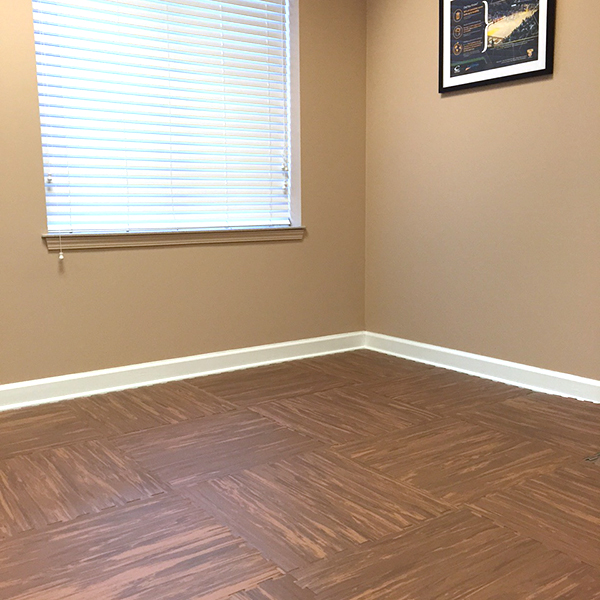Interlocking rubber floor tiles are among the most popular choices for high-traffic areas. Rubber surfaces are easy to clean and extremely resilient, making them ideal for gyms, basements, and recreation rooms. Interlocking tiles come with a unique set of advantages. The following are answers to common questions.
Why choose rubber flooring?
Gyms and rooms in which heavy weights are regularly dropped and sports equipment is stationed benefit from the durability of rubber floors. Since rubber is comfortable and soft underfoot, this type of flooring material is suitable for a wide variety of exercise environments.
What are interlocking rubber floor tiles?
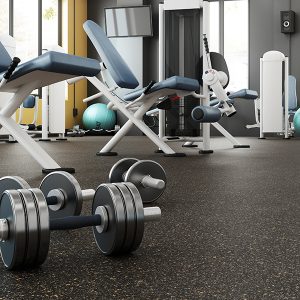 Heavy-duty rubber floor tiles are cut to precision so that they interlock and form a cohesive layer along fitness facility floors. The interlocking tiles provide substantial impact protection. Interlocking rubber floors tiles are convenient options for exercise areas without a rectangular floor plan.
Heavy-duty rubber floor tiles are cut to precision so that they interlock and form a cohesive layer along fitness facility floors. The interlocking tiles provide substantial impact protection. Interlocking rubber floors tiles are convenient options for exercise areas without a rectangular floor plan.
The interlocking tiles are not glued to the floor. Rather, the interlocked tiles are laid out over a flat surface and form a seamless floating floor. Well-designed interlocking rubber floors are held in position by their own weight and do not come apart during normal use.
Do interlocking rubber floor tiles have an odor?
As with any type of rubber product, interlocking rubber floor tiles emit a distinct rubber odor. Upon first installing the tiles, the rubber scent will be the strongest. However, as the flooring airs out over a few weeks or months, the smell of rubber gradually fades.
What is the average cost of rubber floor tiles?
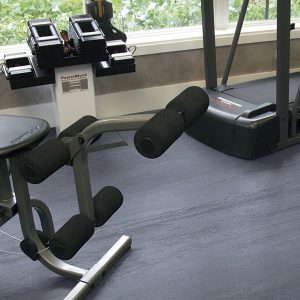 Prices for rubber tiles vary and depend on factors, such as thickness and quality of materials. The size of the floor will impact how many tiles are needed, thereby affecting the price of fitting the entire floor.
Prices for rubber tiles vary and depend on factors, such as thickness and quality of materials. The size of the floor will impact how many tiles are needed, thereby affecting the price of fitting the entire floor.
Rubber tiles average $3 to $10 per square foot. The interlocking feature of the tiles eliminates the need for professional installation, especially in areas with smaller square footage. Since the interlocking rubber tiles are DIY-friendly, the primary costs for the tiles are materials and shipping. Depending on thickness, shipping costs range from $50 to $520.
How are interlocking rubber floor tiles maintained?
Cleaning any type of rubber flooring is straightforward. A damp mop, mild soap (such as a laundry or dish detergent) and water are all that is necessary to remove dirt from the tiles. Before mopping, vacuum the tiles to remove debris particles.
Before using a mild cleaning product, check the manufacturer’s instructions. Harsh chemicals can damage some types of materials. Protecting the interlocking rubber tile seams may be accomplished by applying a seam sealer, which effectively prevents liquids from seeping into the subfloor.
What is the most popular tile thickness?
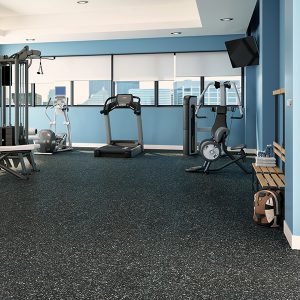 In general, the thicker the floor tiles, the more durable the floor will be. Rubber floor tile thicknesses include 5/16 in (8mm), 13/32″ (10.5 mm),
In general, the thicker the floor tiles, the more durable the floor will be. Rubber floor tile thicknesses include 5/16 in (8mm), 13/32″ (10.5 mm),
5/16 in (8mm) is the most sought-after thickness for interlocking rubber floor tiles. This ideal thickness permits adequate airflow underneath the tiles. Plus, the interlocking mechanism is superior in thicker tiles than thinner ones. Thinner tiles can unlock with strenuous use.
Is installing rubber floor tiles over carpet recommended?
It is possible to see good results when installing interlocking rubber floor tiles over short, low-pile carpeting. An alternative is to lay plywood over the plush carpeting and lay the interlocking tiles over the hard surface.
Installing the rubber floor tiles over carpeting is discouraged if there is a potential for large amounts of water to fall onto the floor. The carpeting under the rubber tiles will absorb the liquid and as a consequence, mold growth is a potential outcome.
How easy or difficult is installation?
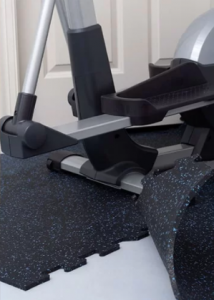
Locking the tiles is as simple as aligning them and snapping the pieces together. Being modular in nature, interlocking rubber tiles can connect even when the alignment is off. Installing the tiles can be done with minimal tools, such as a small mallet.
Are interlocking rubber tiles eco-friendly?
The majority of rubber flooring materials are manufactured out of recycled rubber. Consider that one rubber tire can create 40 pounds of rubber flooring. This means that for every 100 square feet of rubber flooring, a handful of rubber tires are kept out of landfills.
DIYRubberFloors offers high-quality performance flooring. Our interlocking rubber floor systems are ideal for areas where athletics are performed. Through comfort and the transfer of energy, our rubber flooring systems improve athletic performance and safety.
No matter what type of rubber flooring you seek, you will find optimum flooring solutions from the sports flooring professionals at DIYRubberFloors. Call one of our friendly representatives to upgrade your floor.
